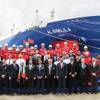Wärtsilä has focused its technological developments in this realm on three main areas: Common-rail fuel injection for heavy-fuel engines; Humidification methods for reduction of NOx; and Dual-fuel engines with micro pilot. Long-term research on the concepts hot combustion for combined cycles and steam injected diesel is also going on.
Common-Rail Fuel Injection
Three engine types, i.e. the Wärtsilä 46, Wärtsilä 38 and Wärtsilä 32 have - so far - been made available for the common-rail injection systems. The pilot engine, which sails onboard the Carnival Spirit, has to date gathered more than 3,500 hours of operational experience, and the Wärtsilä 46 test engine has more than 3,000 hours as well. While there has been a normal amount of teething problems, the experience so far has proven that the basic concepts of the Wärtsilä common-rail system are sound.
The accumulator architecture (Figure 1) has proven very successful in providing excellent pressure stability, meaning that every injection starts from the same rail pressure.
The rail pressure control by linear solenoid valves on the injection pump (Figure 2) provides even better than expected rail pressure accuracy, i.e. the rail pressure is maintained at + 35 bar, while + 100 bar would have been still acceptable.
The injector with the shuttle valve and the press-down piston for the injector needle provides together with the flow fuse total safety against early introduction of fuel into the cylinder. The press-down piston also contributes to excellent smoke behavior. (Figure 3)
The target of smokeless operation at all loads and load pick-up has been reached (Figure 4), and laboratory tests have proven that there is further potential to do even better. Wärtsilä 46 engines with common-rail injection systems for five cruise vessels have been delivered so far. The first Wärtsilä 32 common-rail engines are due for delivery shortly, and during the autumn the first Wärtsilä 38 engines will be retrofitted into common rail.
Humidification for Reduced Nox
Direct Water Injection used to be the Wärtsilä method for combustion air humidification. The system has been developed for common rail engines with side-mounted injector (Figure 5). This configuration is now in field test. The Combustion Air Saturation System (CASS) (Figure 6) has been further tested, and a pilot installation on a Wärtsilä 32 engine will go into operation this autumn. The system is also being qualified for the Wärtsilä 46 engine, and further engine types are likely to follow. The first systems are sold for half the NOx value compared to Marpol Annex VI curve.
Fuel-water emulsion is not promoted for engines with conventional injection systems. With common-rail fuel injection most of the disadvantages are eliminated. Compared to conventional injection systems the common rail offers the following advantages:
• Full load can be reached without increased camshaft torque. In fact the camshaft torque of a common-rail engine is always much reduced compared to conventional engines.
• There will be no risk of cavitation in the high-pressure pump, because the pressure relief process is not taking place in a common-rail high-pressure pump.
• It is possible to optimize the engine both for fuel-water emulsion and pure fuel as different timings and durations can easily be used in both cases.
The NOx reduction of water-fuel emulsion alone might not be very interesting in the current world, because it is limited to 20-25 percent. The reason for Wärtsilä's interest is mainly because of the opportunity to reach ultralow NOx emissions by a combination of Combustion Air Saturation and Fuel-Water Emulsion. A patent application for this combination has been filed.
Dual-Fuel Engine With Micro Pilot
The dual-fuel engine with micro pilot has demonstrated itself as a surprisingly successful concept. Although the micro pilot injects only one percent of the full-load fuel, the igniting capacity of the pilot spray is thousands of times better than from a spark plug. This means that good combustion stability can be reached with leaner mixes, which again allows for higher compression ratios, resulting in high efficiency and improves the possibility to run good performance in the gas mode and in the diesel mode in the same hardware.
Introductions & Updates
Wärtsilä 50DF
While the Wärtsilä 32DF has been on the market for some time, the first installations are at about 20,000 running hours, the Wärtsilä 50DF is a new product introduction. This engine is based on the diesel engine Wärtsilä 46. It offers a cylinder output of 950 kW. The shaft efficiency in gas mode is 47 percent, which is probably a current world record for gas engines. As has been earlier reported, the 50DF has made a breakthrough into the LNG tanker market.
Wärtsilä 38B
With more than 60 engines sold, the Wärtsilä 38B is not exactly a new product introduction, but the fact that this engine is now available also with common-rail fuel injection makes it worth mentioning. The cylinder output of this engine is 725 kW. A test engine is currently being installed in the research center in Trieste. During the autumn the focus will be on endurance testing of the common-rail equipment.
Wärtsilä 32 with Increased Output
The Wärtsilä 32, which is the successor of the Vasa 32, has now been on the market for some time, and with more than 300 engines sold and the first engines passing 25,000 running hours, the engine is now ready for an output increase into 500 kW per cylinder.
Wärtsilä 64
An excellent piece of experience can be reported from the Wärtsilä 64, of which the first engines to go into operation are now approaching 20,000 hours. Thirteen engines are — at the moment — in operation, and up to now in total 12 hours of non-availability have been recorded. Most of those hours were due to a mishap with parts logistics. Mathematically this means that the availability has been more than 99.9 percent and the mean time between failures is calculated to more than 5,000 hours. The step from the Wärtsilä 46 with 1 MW per cylinder into the Wärtsilä 64 with 2 MW per cylinder was certainly a big one, and for that reason no effort was spared in terms of numerical calculations and simulations.
Subscribe for
Maritime Reporter E-News
Maritime Reporter E-News is the maritime industry's largest circulation and most authoritative ENews Service, delivered to your Email five times per week










